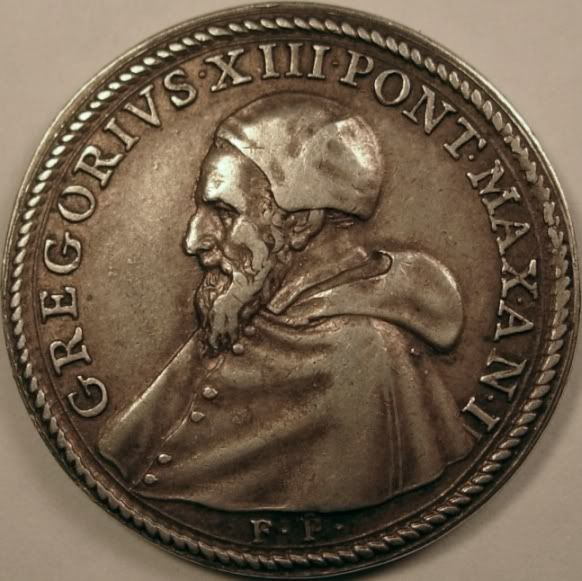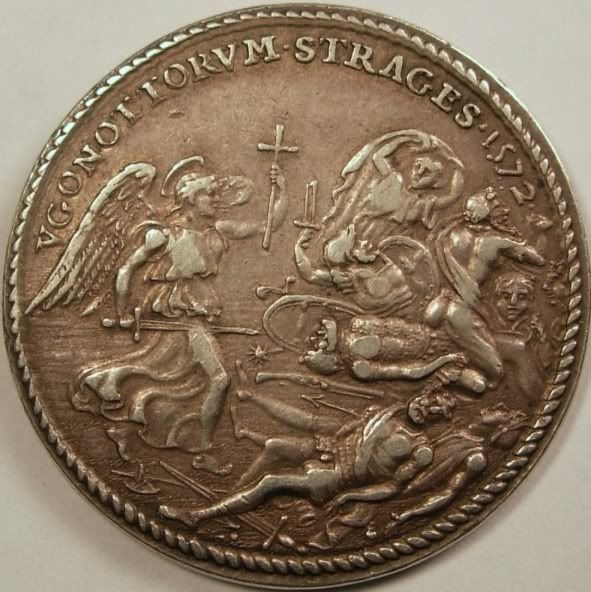Options
Help needed on Silver 1572 Papal Medal
 JRocco
Posts: 14,277 ✭✭✭✭✭
JRocco
Posts: 14,277 ✭✭✭✭✭
This one is a silver piece.
It is dated 1572 and shows Gregory XIII on the obverse and the
reverse shows a depiction of the Massacre of the Huguenots.
It measures 9 on the Mionnet scale.
Any info on this one would be greatly appreciated.
I see a reference in the Spink catalogue to a silver piece that is mounted.
Spink # 699


It is dated 1572 and shows Gregory XIII on the obverse and the
reverse shows a depiction of the Massacre of the Huguenots.
It measures 9 on the Mionnet scale.
Any info on this one would be greatly appreciated.
I see a reference in the Spink catalogue to a silver piece that is mounted.
Spink # 699


Some coins are just plain "Interesting"
0
Comments
<< <i>Pope Gregory XIII, with the dragon of Satan as his heraldic symbol, was also the pope who upon hearing of the wholesale slaughter of Protestant French Huguenots, known as St. Bartholomew's massacre, had a medal struck to celebrate the bloody event. The reverse side of the medal, shown above, depicts an angel with a cross and sword murdering the Huguenot heretics. >>
Here's the Link - search for Huguenots.
More about St. Bartholomew's Day massacre.
8 Reales Madness Collection
Virtus Collection - Renaissance and Baroque Medals
There is a clearly separated punched I after MAX AN 1, that appears to be a different sized numeral 1.
I believe that these were originally punched with AN__blank__
The blank to be filled in with the year, in this case year 1 for the year 1592
I've never heard of the dies being made with blank spots for the numbers; as far as I was aware, new dies were engraved for each year, possibly being modified from copies of the previous year's die, as I have seen some where the numerals (which are part of the design) are going into the side of the bust.
Virtus Collection - Renaissance and Baroque Medals
<< <i>I've never heard of the dies being made with blank spots for the numbers; as far as I was aware, new dies were engraved for each year, possibly being modified from copies of the previous year's die, as I have seen some where the numerals (which are part of the design) are going into the side of the bust. >>
Hi Joe,
I am speculating based on this comment from the 2000 reprint of the Spink Catalogue of Papal Medals made prior to the description of Spink 686
"The following medals, by Lawrence of Parma, have obv. Bust to left, bareheaded,the legend ends -- MAX. A. and a space for the year to be filled in"
And a further comment made just prior to the description of Spink 692
"The following have obv. Bust to left with calotte, and dated AN. 1."
BTW, your medal was (originally) engraved by Gianfederico Bonzagni, (and the obverse design is different than Lorenzo's), so I do not believe that comment applies here.
Virtus Collection - Renaissance and Baroque Medals
I hear what you are saying.
I am actively trying to learn from those of you that know more about these pieces than I do...
and I will keep learning as long as you guys are this willing to teach.
I hope you realize that you are probably teaching quite a few of us at the same time.
I will keep researching this as best I can but let me say again---Thank you for the help.
Virtus Collection - Renaissance and Baroque Medals
My understanding is that this refers only to medals 686-691
That's how I read it too Joe. If you look at the medals after L 745, the dates are filled in, but in arabic numerals (1583), not roman regal years.
Here's an example of 690 without the date added.
I'm just getting into Papal medals, and was curious about the 1572 Gregory XIII on the obverse and the
reverse depiction of the Massacre of the Huguenots. How available are these? Any idea how many were made? I figure the silver is less common than the bronze, how much would each run now?
Thanks in advance!
Greg
On the original medal reverse, there seems to be a blunderbuss
under the dead man's head, lower center.
I wonder if this is the first numismatic appearance of a firearm.
The copper restrike seems to have edited it out.
The Mysterious Egyptian Magic Coin
Coins in Movies
Coins on Television
The number originals minted for this and most pre 1700 medals is generally not known (the annual series being a notable exception). And, as far as I know there is no record of restrikes either. But, in terms of scarcity, this was a popular medal and the coppers are one of the most common of the early types. There tend to be one or two coppers on ebay every time I look (may be the same ones just being relisted). Price is all over the place since a lot of sellers don't know (or care) about the series and availability of restrikes. A quick scan of ebay reveals 3 copper restrikes on ebay at the moment. One has been bid up to euro 11.50 closing tomorrow. The other two have buy it now prices closer to USD $200 but I think they've been there for a while. Something well under $100 for a bronze seems fair to me, altho you might find a "buy." if you're patient. By contrast, the silver is a real prize. I don't have and don't recollect seeing anther silver offered and $200-300 is probably fair for one in nice shape so long as you realize what you're buying. And, if its nice, you might have to outbid me for it. Just M(sometimes not so)HO, however, and others might have a different read on these.
I like the historical aspect of the Gregory XIII medal. I do read Italian, so the CNORP set may be worthwhile, if I can find them at a reasonable price.